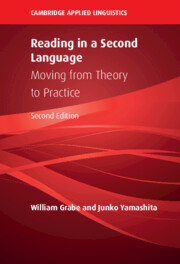Book contents
- Reading in a Second Language
- The Cambridge Applied Linguistics Series
- Reading in a Second Language
- Copyright page
- Dedication
- Contents
- Figures
- Tables
- Preface
- Part I Foundations of Reading
- Part II Patterns of Variation in Reading
- Part III Developing Reading Comprehension Abilities
- Part IV Expanding Reading Comprehension Skills
- 15 Reading to Learn and Reading–Writing Relationships
- 16 Reading in Digital Contexts
- 17 Reading Fluency, Reading Rate, and Comprehension
- 18 Extensive Reading
- Part V Applications of Reading Research: Instruction and Assessment
- References
- Author Index
- Subject Index
15 - Reading to Learn and Reading–Writing Relationships
from Part IV - Expanding Reading Comprehension Skills
Published online by Cambridge University Press: 01 September 2022
- Reading in a Second Language
- The Cambridge Applied Linguistics Series
- Reading in a Second Language
- Copyright page
- Dedication
- Contents
- Figures
- Tables
- Preface
- Part I Foundations of Reading
- Part II Patterns of Variation in Reading
- Part III Developing Reading Comprehension Abilities
- Part IV Expanding Reading Comprehension Skills
- 15 Reading to Learn and Reading–Writing Relationships
- 16 Reading in Digital Contexts
- 17 Reading Fluency, Reading Rate, and Comprehension
- 18 Extensive Reading
- Part V Applications of Reading Research: Instruction and Assessment
- References
- Author Index
- Subject Index
Summary
Chapter 15: Reading to Learn and Reading-Writing Relationships. This chapter examines research on the close relationship between reading comprehension and writing abilities. The focus of this research has been on how writing can support more advanced reading comprehension, and how engaging students in complex content-based texts and tasks will better prepare students to become both more proficient academic readers and more effective writers. This instructional trend to develop more proficient academic readers and writers is true for both L1 and L2 students, and in both secondary and post-secondary contexts. A third key concept in the reading-writing relationship is the important, but less explored role of content knowledge. The chapter then reviews two specific instructional formats for developing reading-writing relationships: summary writing and synthesis writing. The chapter concludes with implications for instruction.
Keywords
- Type
- Chapter
- Information
- Reading in a Second LanguageMoving from Theory to Practice, pp. 371 - 387Publisher: Cambridge University PressPrint publication year: 2022

